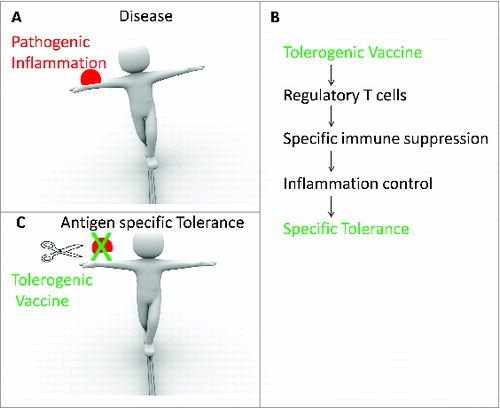Figures & data
Figure 1. Tolerogenic vaccines are proposed to induce antigen specific control of pathogenic inflammation. (A) Balance between inflammation and tolerance guarantees immune homeostasis and individual survival. (B) Pathogenic inflammation leads to diseases such as autoimmunity, allergy, etc. (C) Non-specific intervention impairs protective immune responses and increases risks of infection or tumorigenesis. (D) Tolerogenic vaccine, as antigen specific intervention, may restore balance and provide a cure.
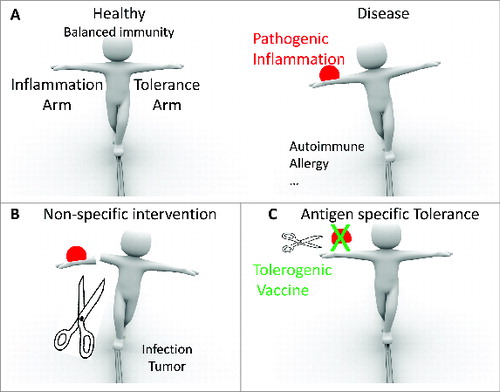
Table 1. Non-specific interventions of inflammation
Figure 2. A history of tolerogenic vaccines as specific interventions for inflammatory diseases. (A) Timeline of vaccine discovery. (B) Current state of tolerogenic vaccines. SIT: specific immunotherapy. TolerogenicVac: tolerogenic vaccine. Td: Time of discovery. Trial: clinical trials from USA, Europe and China. Ist: Immunosuppressant. Aprv: Approved by USA FDA or European Union. Spec: antigen specificity. RA: rheumatoid arthritis. MS: multiple sclerosis. T1D: type 1 diabetes. AD: Alzheimer Disease.
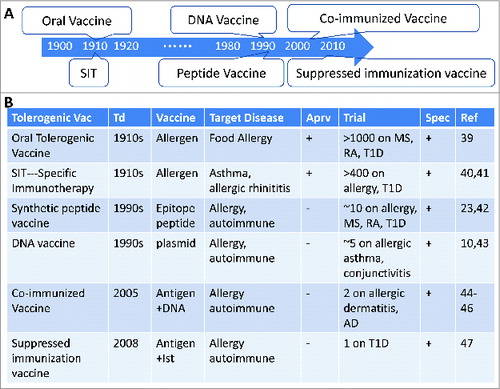
Figure 3. Combination vaccination controlled new-onset diabetes and cytotoxic inflammation in NOD mice. New-onset diabetic NOD mice were treated with rh-insulin plus DEX (10 μg+10 μg) at days 1, 4 and 7. (A) Blood glucose was measured at intervals for 28 d Dashed line indicates the diabetes threshold (16.7 mmol/L). Square bracket indicates the normal glucose range of healthy animals (5∼12 mmol/L). (B) Percentage of regulatory T cells among draining lymph node cells. n = 6. On day 14, in vivo cytolytic assay (CTL) was performed against islet cell (C), insulin 10–18 epitope (D) or preproinsulin 15–24 (E). Unvaccinated mice were used as CTL control. Anti-CD8 mAb was i.p. injected to block CTL in unvaccinated mice as positive control. n = 4. Data represent 3 independent experiments.
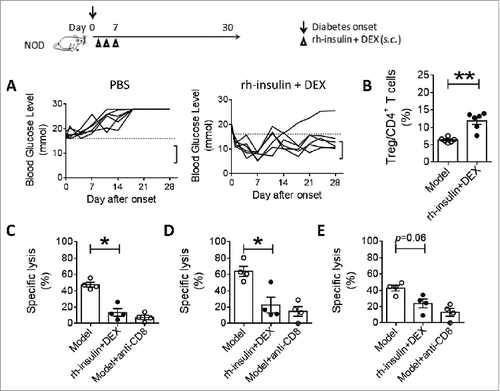
Table 2. Safety assessments
Figure 4. Combination vaccination induced immune suppression in rabbit and dog. Rabbits and dogs were vaccinated at day 1, 4 and 7. At day 10, Tregs were analyzed in draining LNs of rabbits (A) or dogs (C). After in vitro restimulation with rh-insulin for 24 h, IL-10/TGF-β mRNA was analyzed in LN cells of rabbits (B) or dogs (D). n = 4. Data represent 3 independent experiments.
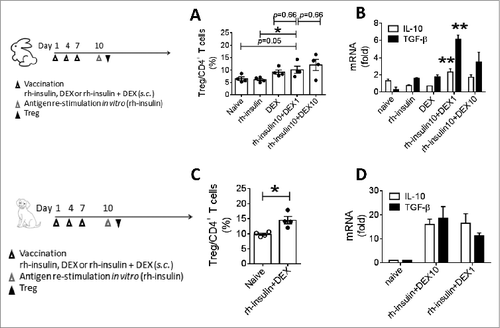
Figure 5. Suppressed immunization vaccine controlled human dendritic cell maturation. PBMC from 2 T1D patients (A, C) and 3 healthy donors (B, D) were cultured with rh-insulin, DEX or the combination for 3 d. Dendritic cell maturation (A, B) and IL-10 secretion in culture were analyzed (C, D).
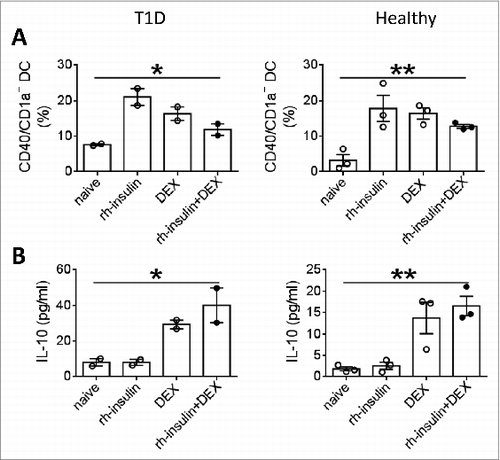
Table 3. Mechanism of induction of Tregs by tolerogenic vaccines
Figure 6. Treg as a mechanism for tolerogenic vaccines. Specific tolerance targeting pathogenic inflammation (A) can be induced by tolerogenic vaccine through various mechanisms including Treg (B), and in turn ameliorates disease progression (C).
